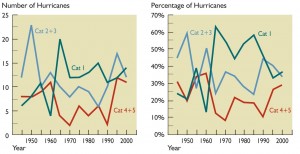Rate of Global Warming is Slowing and Nobody Knows Why
Despite hype to the contrary, the world has seen a slowdown in the rate of warming over the past few years. The change is causing many scientific organizations to adjust their climate change projections. Late last year the Intergovernmental Panel on Climate Change reduced its projected warming from a range of 0.4 to 1.0 degrees Celsius to 0.3 to 0.7 degrees Celsius between 2016 and 2035. More importantly, nobody seems to know why the warming has slowed.
The leading theory is that the increased heat has been partially absorbed by the ocean. A group at the Scripps Institute suggested the extra heat is being absorbed by the surface waters of the Pacific Ocean. Other scientists suggest that the deeper, colder parts of the ocean are absorbing the heat. Another theory is that active volcanoes are suppressing global warming by spewing ash and gas that reflect the sun’s heat back into space. Some have suggested particulate matter from coal power plants in developing countries spewed into the atmosphere may be reflecting sunlight thereby reducing heat. Others think that an exceptionally active solar cycle may be influencing temperatures.
The scientific method has always been a five-step process involving a question, a research hypothesis, experimentation and data analysis. While most scientists now believe humans play a significant role in global warming, the exact level is up for debate. And past projections have been off sometimes significantly. In one of the first predictions, Dr. James Hansen told Congress in 1988 that the world would warm 1.0 degree Celsius every 20 years until 2050. We now know that figure was 2-3 times too high.
Where does this leave policy makers and citizens? Policy makers should continue to develop free-market oriented solutions to global warming. Some folks favored a carbon tax, but its lack of success in Europe has pushed many towards carbon capture instead. Other potential solutions are worthy of consideration.
At the same time, scientists should emphasize that all predictions are estimates. The earth and its atmosphere are complicated places; we still have a lot to learn on climate change. Everybody should remember that science is not religion; actual facts are needed before a conclusion can be made. There is one thing that we can be certain of today: nobody can predict with 100% accuracy what any aspect of earth, including its climate, will be like in 2050.

